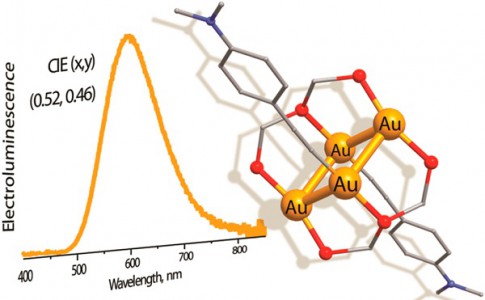T.M. Dau, Y.-A. Chen, A.J. Karttunen, E.V. Grachova, S.P. Tunik, K.-T. Lin, W.-Y. Hung, P.-T. Chou, T.A. Pakkanen, I.O. Koshevoy
“Tetragold(I) Complexes: Solution Isomerization and Tunable Solid-State Luminescence”
Inorg. Chem., 2014, accepted
In this study, a new family of tetranuclear gold(I)triphosphine derivatives bearing alkynyl and thiolate groups have been efficiently synthesized by treating the polymeric acetylides (AuC2R)n or a thiolate (AuSPh)n sequentially with the (a) phosphine ligand and (b) cationic complex [Au3(P^P^P)2]3+ (P^P^P = PPh2CH2PPhCH2PPh2). The clusters [Au4(P^P^P)2(C2R)2]2+ [R= Ph (1), biphenyl (2), terphenyl (3), C6H4OMe (4), C6H4NMe2 (5), C6H11O (6), and C6H4CF3 (7)] and [Au4(P^P^P)2(SPh)2]2+(8) were characterized by X-ray crystallography in the solid state.
NMR spectroscopic investigations in solution revealed that the majority of alkynyl clusters 1−7 exist as two isomeric species in slow chemical equilibria. All complexes 1−8 exhibit moderate-to-strong photoemission in the solid state with quantum yields from 0.07 to 0.51. The luminescence behavior was rationalized using quantum chemical density functional theory methods. The high emission efficiency of these tetragold(I) compounds and their good stability in film allowed for the fabrication of an organic electroluminescent device (OLED). Employing complex 5 (Φ = 0.51), an OLED was fabricated under a solution process to give a good external quantum efficiency of 3.1%, corresponding to a current efficiency of 6.1 cd/A and a power efficiency of 5.3 lm/W, with Commission Internationale de I’Eclairage coordinates of (0.52, 0.46).
